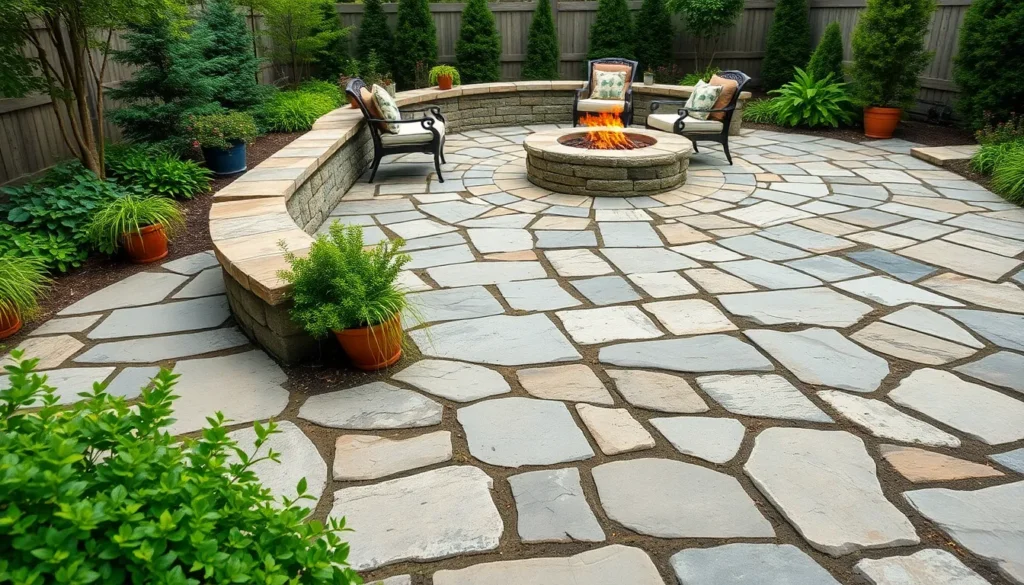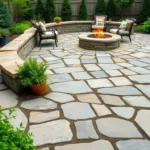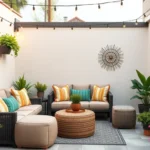We’ve all dreamed of that perfect outdoor space where we can unwind after long days and entertain friends on warm summer evenings. Flagstone patios offer the ideal solution, combining natural beauty with incredible durability that’ll transform your backyard into a stunning retreat.
Flagstone’s unique textures and earthy colors create an organic elegance that complements any industry design. Whether you’re envisioning a cozy intimate gathering spot or a grand entertainment area, these versatile natural stones adapt to your vision while adding important value to your property.
From classic rectangular layouts to creative mosaic patterns, we’ll explore inspiring flagstone patio ideas that suit every style and budget. You’ll discover how to maximize your outdoor living potential with designs that seamlessly blend functionality and aesthetic appeal, creating the backyard oasis you’ve always wanted.
Natural Fieldstone Patio Designs for Rustic Charm
Natural fieldstone brings an authentic countryside feel to outdoor spaces through its organic textures and earth-toned colors. We’ll explore design elements that maximize fieldstone’s rustic appeal while creating functional outdoor living areas.
Irregular Stone Patterns
Irregular stone patterns create the most natural-looking fieldstone patios by mimicking how stones naturally occur in nature. We recommend using stones of varying sizes, from 12-inch to 36-inch pieces, to achieve an authentic random appearance. Polygonal layouts work exceptionally well with fieldstone since they accommodate the natural edges and unique shapes of each stone piece.
Crazy paving techniques offer maximum design flexibility when working with irregularly shaped fieldstone pieces. We position larger stones as anchor points throughout the patio, then fill surrounding areas with medium and smaller stones. This approach creates visual interest while ensuring structural stability across the entire surface.
Organic flowing patterns complement fieldstone’s natural characteristics better than rigid geometric designs. We avoid straight lines and perfect angles, instead following the stone’s natural contours to create meandering pathways and curved edges. This technique produces patios that appear to have formed naturally over time.
Moss and Grass Joint Fillers
Moss joint fillers enhance fieldstone patios with authentic woodland charm while requiring minimal maintenance once established. We plant moss spores directly into sand-filled joints during spring months when moisture levels support growth. Irish moss and Scottish moss varieties thrive in most climates and create a lush green carpet between stones.
Grass joint fillers provide a softer walking surface compared to traditional mortar or sand options. We use fine fescue or creeping thyme in joints wider than 1 inch to create living pathways. These plants tolerate foot traffic while adding natural fragrance and seasonal color changes to the patio design.
Chamomile ground cover transforms fieldstone joints into aromatic pathways that release pleasant scents when walked upon. We plant chamomile seedlings in joints during early spring, spacing them 6 inches apart for optimal coverage. This living joint filler blooms with small white flowers throughout summer months.
Weathered Stone Selection
Weathered fieldstone pieces add instant character to new patio installations through their naturally aged appearance. We source stones from old farm walls, demolished foundations, or specialized quarries that offer pre-weathered materials. These stones feature rounded edges, lichen growth, and color variations that can’t be replicated artificially.
Limestone fieldstone develops beautiful patina over decades of natural weathering processes. We select pieces showing gray, tan, and cream color variations with visible fossil impressions and natural pitting. Pennsylvania bluestone and Tennessee fieldstone offer excellent weathered options for rustic patio designs.
Sandstone varieties provide warm earth tones that complement natural landscaping elements perfectly. We choose sandstone pieces with visible layering, natural fracture lines, and surface textures created by wind and water erosion. Colorado sandstone and Ohio sandstone deliver exceptional weathered characteristics for authentic rustic appearances.
Geometric Flagstone Layouts for Modern Appeal
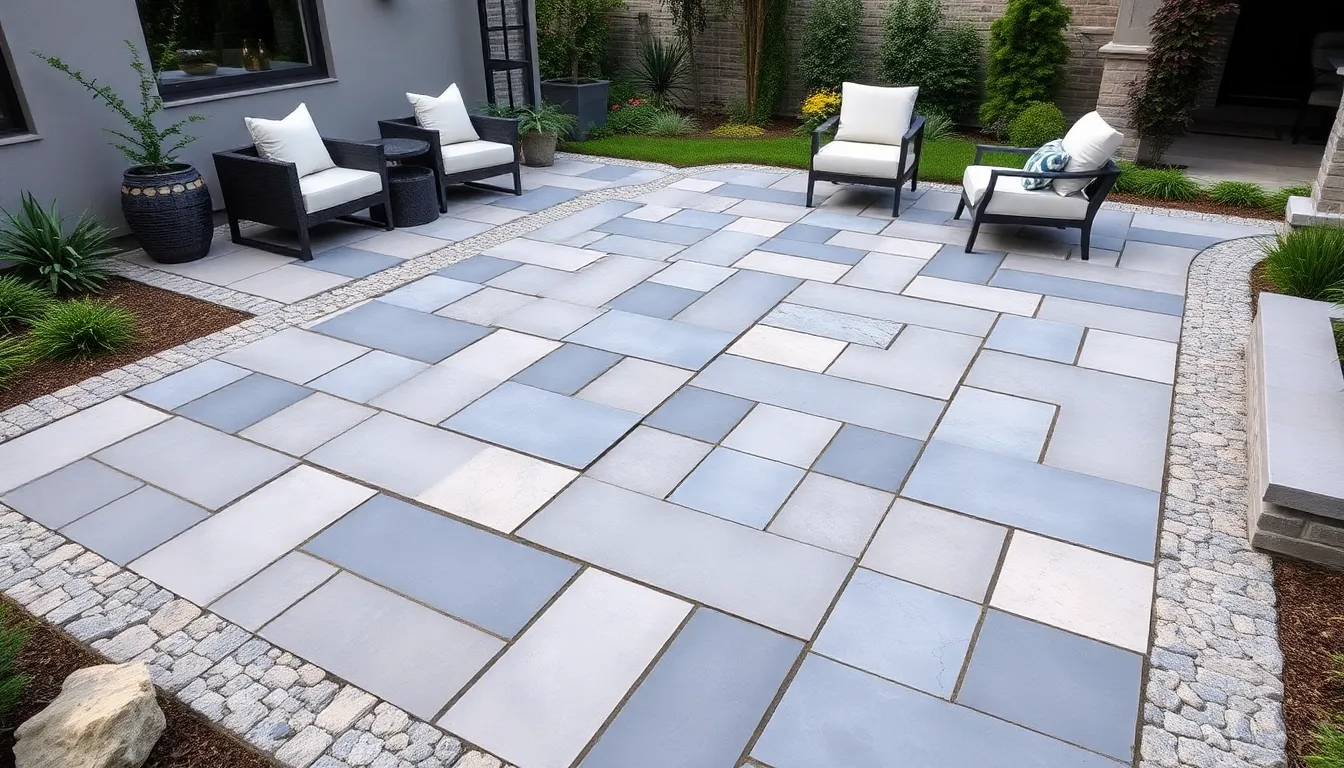
Moving away from organic fieldstone patterns, geometric flagstone layouts bring structure and contemporary sophistication to outdoor spaces. We’ll explore how precisely cut stones and deliberate arrangements create striking modern patios that complement today’s architectural styles.
Square Cut Stone Arrangements
Square cut flagstones transform patios into sleek, organized spaces that mirror contemporary design principles. We recommend using uniform rectangles and squares in varying sizes to create visual interest while maintaining clean lines throughout your installation.
Rectangular patterns offer the most popular approach for modern flagstone patios. Cut stones into perfect rectangles of different dimensions, then arrange them at random intervals across your patio surface. This technique provides balanced composition without appearing rigid or predictable.
Tight fitting joints create smooth, polished surfaces that work exceptionally well with modern outdoor furniture. We suggest keeping joint spacing minimal when you want a seamless appearance that emphasizes the stone’s natural beauty.
Wider joint spacing allows for a more relaxed feel while retaining geometric precision. Fill these spaces with decomposed granite or small pebbles to maintain the contemporary aesthetic while preventing weed growth.
Linear Pattern Installations
Linear flagstone patterns guide the eye and create impressive visual flow across your patio space. We use straight lines and grid arrangements to make areas appear larger and more open than traditional random layouts.
Grid installations work best when you combine various stone sizes within straight line patterns. Place larger stones as anchor points, then fill surrounding areas with smaller rectangular pieces to prevent monotony while maintaining streamlined appearance.
Directional patterns enhance space perception by drawing attention toward exact features. Run linear patterns toward fire pits, outdoor kitchens, or garden focal points to create natural pathways and improve traffic flow.
Parallel arrangements suit narrow patios and walkways perfectly. Install stones in parallel rows with consistent spacing to create rhythm and movement that complements modern industry design.
Contrasting Border Designs
Contrasting borders define patio edges and add sophisticated finishing touches to geometric flagstone installations. We create dramatic visual impact by using different colored stones, varied textures, or alternative materials around patio perimeters.
Color contrasting produces the most striking results when you pair light and dark flagstones. Frame lighter Arizona flagstone patios with darker border stones, or reverse this combination to highlight your patio as the main focal point.
Size variation adds dimensional interest without requiring different stone types. Use larger flagstones for borders around smaller interior pieces, or create narrow borders with smaller stones surrounding larger central sections.
Material mixing allows you to incorporate complementary elements like brick, concrete pavers, or metal edging. These contrasting materials tie geometric flagstone patios to surrounding architecture and create seamless transitions to landscaping features.
Multi-Level Flagstone Patio Configurations
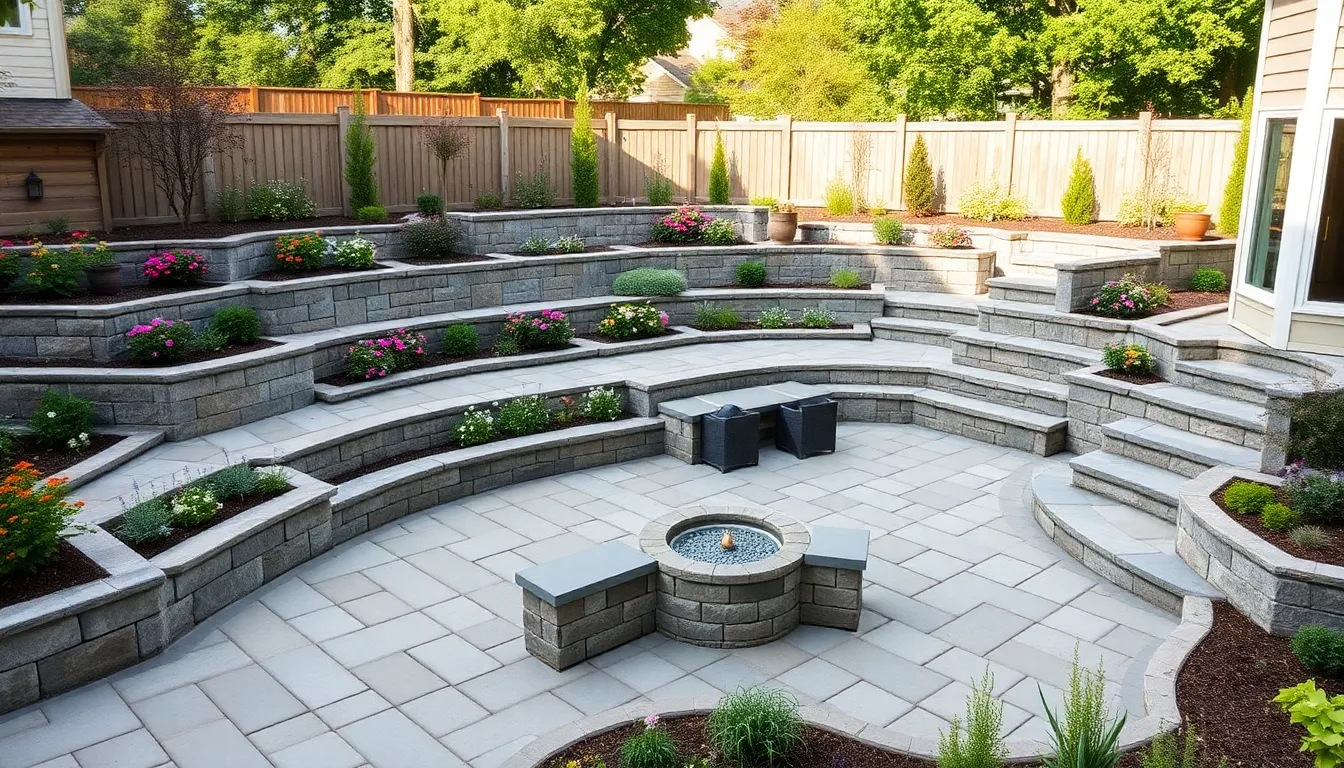
Multi-level flagstone patios transform ordinary outdoor spaces into ever-changing environments that maximize both function and visual appeal. We create distinct zones through strategic elevation changes that connect seamlessly with steps or gradual slopes.
Tiered Seating Areas
Tiered seating arrangements capitalize on multi-level patio designs by incorporating built-in seating at different elevations throughout the space. We position these seating areas to accommodate various group sizes while creating intimate conversation nooks that feel naturally separated yet connected. Strategic lighting placement around each tier enhances evening ambiance and extends usability well into the night.
Built-in stone benches at different levels encourage natural gathering patterns and social interaction. We integrate fire pits into lower tiers to create focal points that draw people together during cooler evenings. The varying heights provide comfortable sightlines across the entire patio space while maintaining an open, flowing atmosphere.
Raised Planter Integration
Raised planters constructed from matching flagstone materials add essential height variation and natural greenery to multi-level patio designs. We edge these planters entirely with flagstone to create seamless transitions between hardscape and industry elements. The planters serve as natural room dividers that define different functional areas without creating visual barriers.
Strategic planter placement around seating and entertainment zones creates focal points that enhance the overall aesthetic appeal. We fill these raised beds with flowering plants, ornamental shrubs, and seasonal displays that provide year-round visual interest. The elevated design improves drainage while making plant maintenance more accessible and comfortable.
Step-Down Entertainment Zones
Step-down entertainment areas create dedicated spaces for exact activities like outdoor cooking, dining, or lounging within the larger patio framework. We design these sunken zones with a small number of flagstone steps that provide safe, slip-resistant transitions between levels. The separation naturally encourages traffic flow while maintaining the patio’s open, connected feeling.
Outdoor kitchens positioned in step-down areas benefit from the natural windbreak effect of surrounding elevated surfaces. We incorporate water features like fountains or small waterfalls into these lower zones to create multi-sensory experiences that combine the sounds of flowing water with the visual appeal of natural stone. Fire pits installed in sunken seating areas provide warmth and ambiance while containing flames safely below the main patio level.
Flagstone Fire Pit Integration Ideas
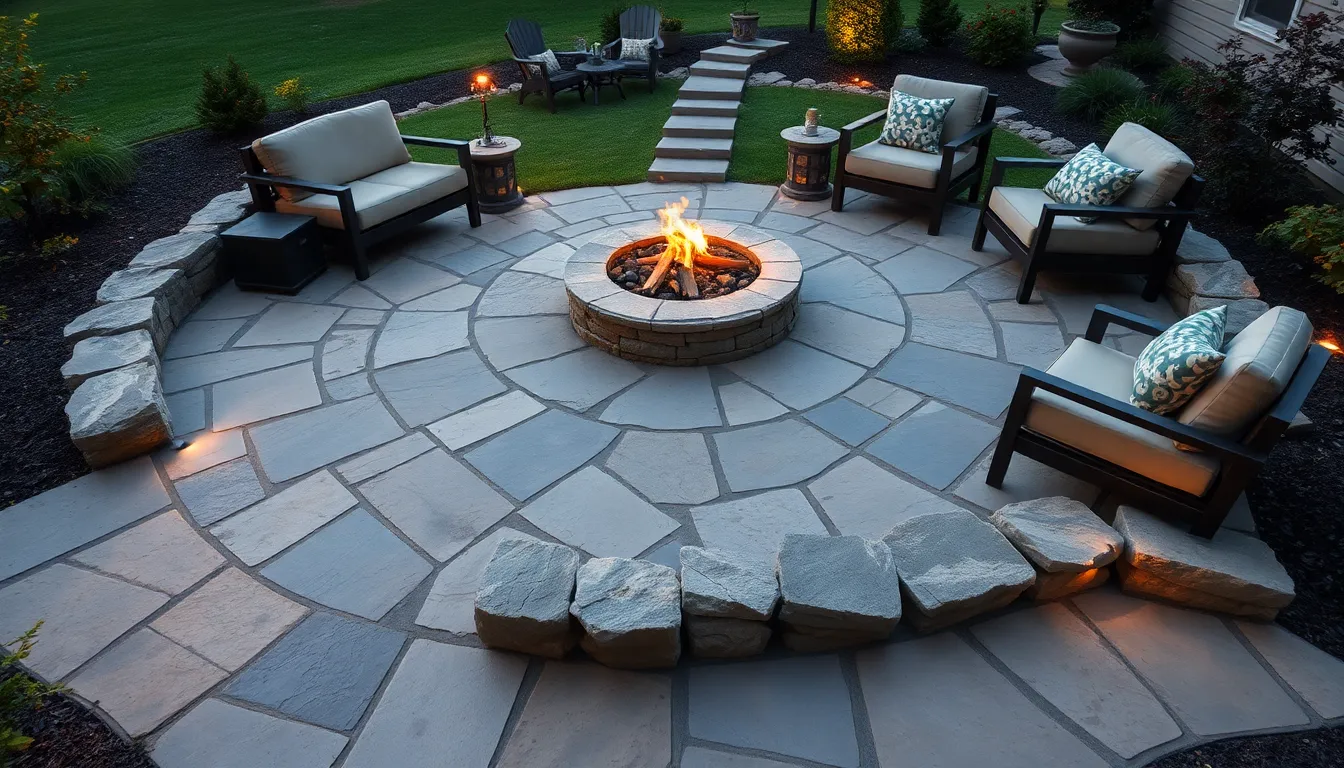
We’ve found that incorporating fire features into flagstone patios creates the perfect balance between natural beauty and functional warmth. These installations transform your outdoor space into a year-round gathering spot that enhances both entertainment value and property appeal.
Circular Stone Fire Features
Circular fire pits create the ultimate social gathering environment where conversations flow naturally around the warm flames. We recommend arranging flagstone in circular patterns that echo the fire pit’s shape while encouraging comfortable seating from all angles. Large uneven stones mixed with uniformly cut pieces provide the perfect balance between randomness and cohesion that mimics natural stone formations.
Stone placement around circular features should emphasize accessibility from every direction while maintaining organic patio shapes that feel inviting. We’ve discovered that varying the flagstone sizes prevents clustering of similar pieces and creates visual interest that draws people toward the fire. Natural texture variations in the flagstone complement the warm glow beautifully and establish a cozy focal point for evening gatherings.
Rectangular Fire Table Designs
Rectangular fire tables offer sleek modern alternatives that integrate seamlessly with contemporary outdoor kitchens and dining areas. We suggest surrounding these features with flagstone patios designed using mismatched or uniform rectangular stones to create harmonious yet eclectic appearances. This approach combines cooking and social spaces into one functional entertainment zone.
Contemporary designs benefit from precisely arranged rectangular flagstones that complement the clean lines of modern fire table installations. We often recommend incorporating these features into larger patio layouts where the geometric shapes create visual continuity between different outdoor living zones. Fire table surrounds work exceptionally well when the flagstone pattern mirrors the table’s rectangular form while maintaining design flexibility.
Safety Zone Stone Borders
Wide stone borders create essential heat buffers and visual boundaries that keep seating and foot traffic at safe distances from fire features. We always design these safety zones using flagstone to define non-flammable perimeters that prevent accidents while maintaining aesthetic continuity. These borders serve dual purposes by protecting guests and highlighting the fire feature as a central design element.
Low voltage LED lights installed beneath flagstone edges and safety borders provide subtle illumination that enhances nighttime ambiance and improves visibility. We recommend creating borders that act as natural walkways leading to and around fire features while clearly defining safe zones. Stone border lighting highlights steps and zone edges effectively while adding sophisticated finishing touches that extend the patio’s usability into evening hours.
Flagstone Pool Deck and Water Feature Combinations
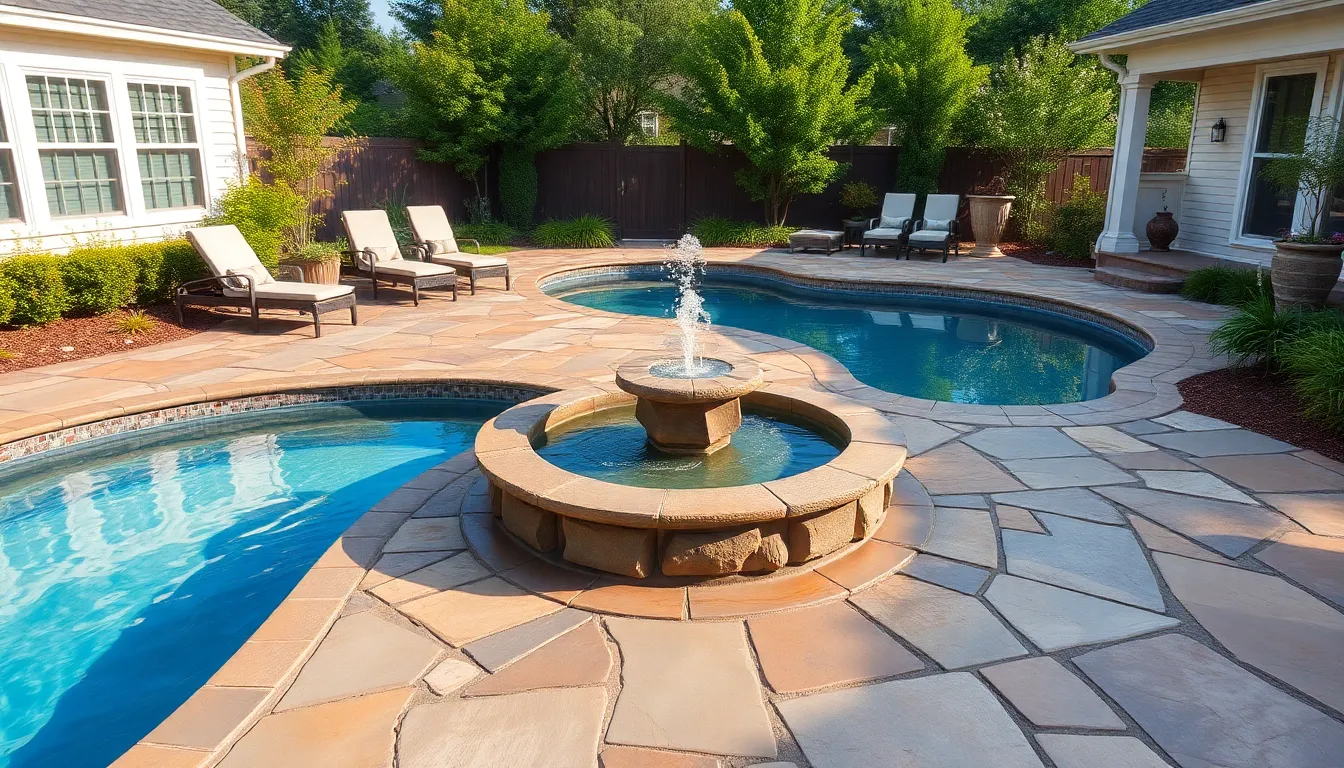
We can transform our outdoor space into a tranquil retreat by incorporating water features such as fountains, waterfall walls, or ponds bordered with flagstone. This natural stone creates a multisensory experience that blends beautifully with gravel or aggregate surrounds.
Non-Slip Surface Treatments
Flagstone naturally provides a textured, slip-resistant surface that works perfectly for pool decks and patio areas. We recommend selecting flagstone with a rough or natural cleft finish to improve traction around wet areas where safety becomes critical.
Creating narrow joint spacing with tight-fitting flagstones delivers a smooth yet secure surface for daily use. Alternatively, we can install wider joints filled with sand or gravel to add earthy style while maintaining excellent drainage properties.
The key lies in balancing aesthetics with functionality when choosing our surface treatment approach. We’ve found that natural stone textures offer superior grip compared to polished alternatives.
Drainage Consideration Designs
Proper drainage design becomes essential when installing flagstone patios near pools or water features. We start by grading and digging down 3-6 inches to create the foundation for our drainage system.
| Drainage Layer | Depth | Material | Purpose |
|---|---|---|---|
| Base Layer | 3-4 inches | Compacted gravel | Structural support |
| Top Layer | 1-2 inches | Decomposed granite or sand | Permeability |
| Stone Gaps | Varies | Slight spacing | Water runoff |
Laying flagstones like puzzle pieces with slight gaps encourages water runoff away from structures. We angle the slopes to prevent pooling and potential stone damage over time.
Incorporating drainage systems under and around water features ensures long-term durability of our installation. This prevents water accumulation that could compromise the stone foundation.
Waterline Stone Transitions
Waterline stone transitions create seamless connections between pools and patios using flagstone edges for natural aesthetic appeal. The stone forms a border or coping that visually and functionally separates water areas from dry spaces.
Using flagstone in waterline transitions creates cohesive design language by matching our patio stone material. This approach blends hardscape and pool elements seamlessly while maintaining consistent visual flow.
We integrate slip-resistant properties at pool edges where safety remains paramount for users. The natural texture of flagstone provides excellent grip even when wet from splash or pool activity.
Drainage answers handle splash and runoff effectively when properly integrated into waterline designs. This prevents water damage while maintaining the elegant appearance of our stone transitions.
Flagstone Pathway Connection Concepts
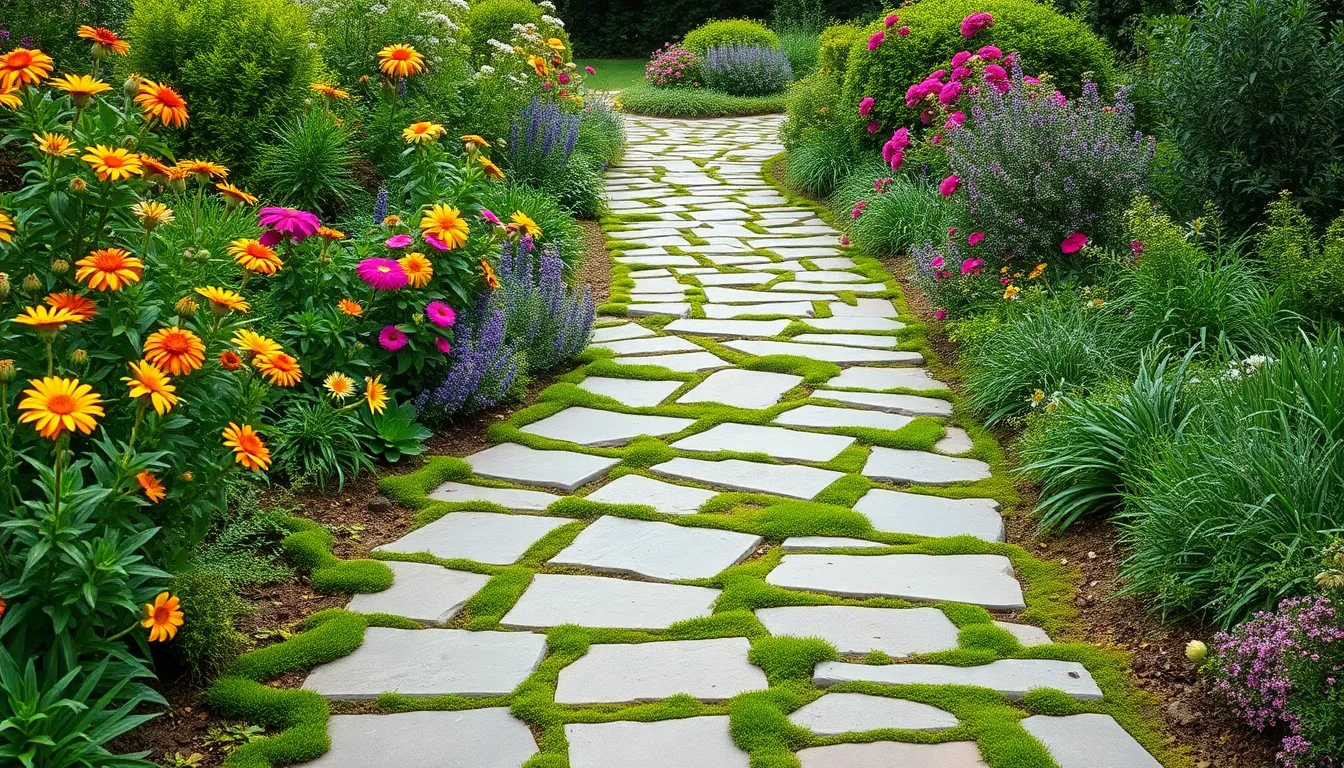
Creating seamless connections between your flagstone patio and surrounding industry elements transforms your outdoor space into a cohesive design masterpiece. We’ll explore three essential pathway approaches that enhance both functionality and visual appeal.
Meandering Garden Walkways
Curved flagstone paths offer the most natural way to connect your patio with garden areas and create an inviting exploration experience. These winding walkways encourage leisurely strolls through your industry while adding visual interest that complements organic garden elements like flower beds, shrubs, and trees.
Irregular flagstone shapes work perfectly for meandering designs since their organic edges follow natural curves without creating harsh lines. We recommend using varying stone sizes to maintain visual balance while allowing the path to flow naturally around existing landscaping features like mature trees or garden beds.
Plants and gravel between flagstone joints enhance the organic feel of curved pathways. Moss, creeping thyme, or small ornamental grasses can soften the stone edges and create a living carpet effect that changes with the seasons.
Straight Access Routes
Direct flagstone pathways provide clean, functional answers for high traffic areas and create strong visual lines that connect different outdoor living spaces. These linear designs work especially well when you need efficient access between your patio and frequently used areas like outdoor kitchens, pool decks, or garden gates.
Tight joint layouts between flagstones create uniform surfaces that handle heavy foot traffic while maintaining a sophisticated appearance. We suggest using rectangular or square cut flagstones for straight paths since their precise edges allow for consistent spacing and professional installation results.
Contrasting border materials like brick or steel edging can define straight flagstone paths and prevent stones from shifting over time. This approach also creates clear boundaries between your pathway and surrounding lawn or planted areas.
Stepping Stone Transitions
Individual flagstones placed as stepping stones create smooth transitions between different patio zones while blending hardscape elements with grass or gravel areas. This method allows you to guide visitors along planned routes without overwhelming smaller spaces with continuous stone coverage.
Strategic placement of stepping stones across lawn areas connects separate outdoor living spaces like dining patios, fire pit areas, and garden retreats. We recommend spacing stones 18 to 24 inches apart for comfortable walking stride and visual continuity throughout your industry design.
Natural stone texture variations in stepping stone installations add visual interest while maintaining the cohesive flagstone theme across your entire outdoor space. Large statement stones can mark transition points between different activity areas, while smaller stones create subtle pathways through planted garden zones.
Flagstone Furniture and Built-In Seating Options
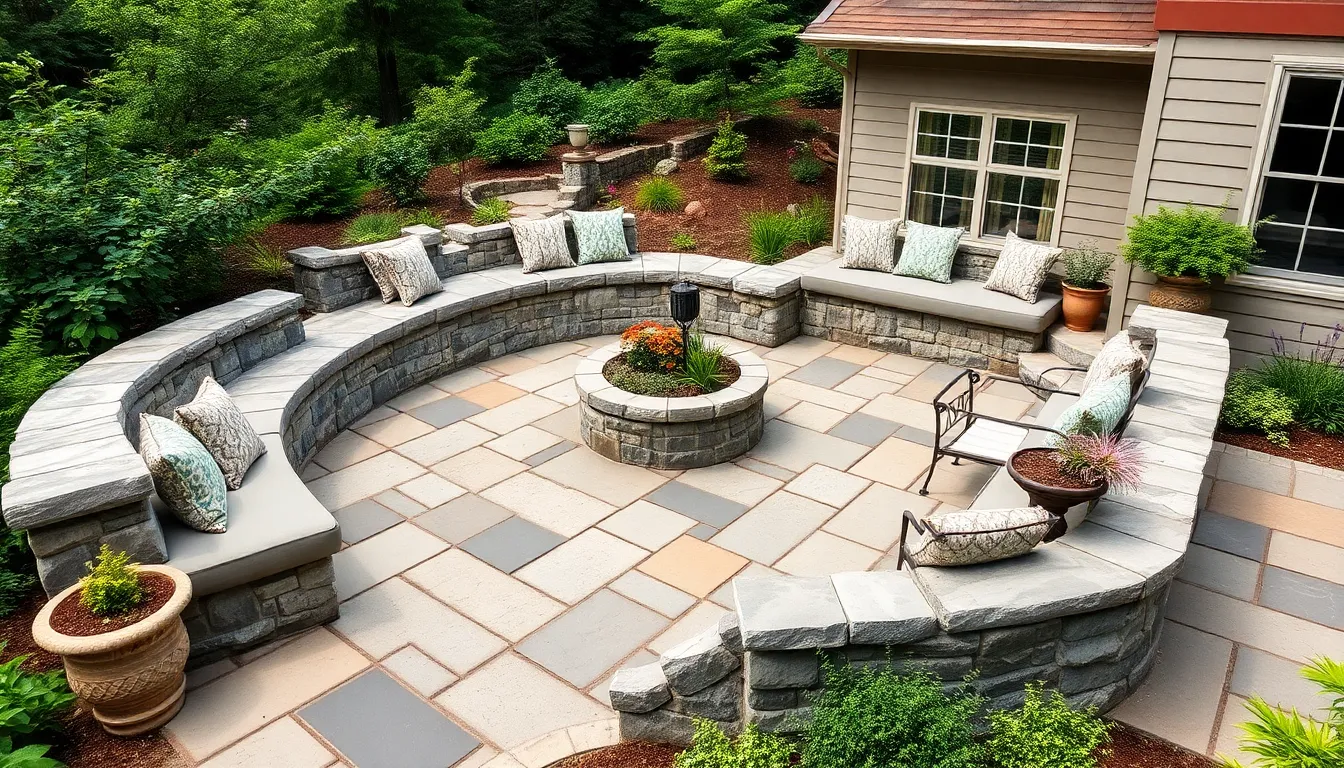
We can transform our flagstone patios into complete outdoor living spaces by incorporating furniture and seating elements directly into the stone design. Built-in seating creates permanent, weather-resistant answers that seamlessly blend with our patio’s natural aesthetic.
Stone Bench Constructions
Stone benches constructed from large, flat flagstone slabs offer the most durable seating solution for our patios. We can create these benches by placing thick flagstone slabs on stone or concrete bases, ensuring stability and longevity for years of outdoor use.
Simple flat surface designs work well for minimalist patios, while sculptural custom-built forms can match our exact flagstone patterns and layouts. Bench heights typically range from 16 to 18 inches for comfortable seating, with depths of 12 to 15 inches providing adequate support.
Integration with existing patio borders creates cohesive designs that feel naturally connected to our outdoor space. We can position these benches around fire pits or along patio edges to maximize both functionality and visual appeal.
Integrated Planter Seating
Planter benches combine the functionality of seating with the beauty of greenery by incorporating raised planters directly into our bench structures. We can create both the planter exterior and adjacent seating from matching flagstone to create cohesive, multifunctional outdoor furniture.
These integrated designs increase our patio’s ambiance by blending natural plant elements with the stone seating areas. Planters can be built at varying heights to create visual interest while providing comfortable seating at standard bench height.
Drainage considerations become crucial when we design planter seating, requiring proper waterproofing behind the stone and adequate drainage holes. We should select plants that complement our flagstone colors and thrive in our exact climate conditions.
Corner Nook Designs
Corner nooks built with flagstone provide cozy, private seating areas that maximize our patio’s space usage while creating intimate spots for relaxation. We can design these nooks with curved or angled stone benches that frame the corner area naturally.
Built-in fire pits often enhance these corner designs, creating warm gathering spaces perfect for evening conversations. Cushions and outdoor pillows can soften the stone seating while adding color and comfort to our corner retreats.
These nooks work particularly well in larger patios where we want to create distinct zones for different activities. We can incorporate additional features like small side tables or storage compartments within the stone construction for added functionality.
Flagstone Patio Lighting Enhancement Ideas
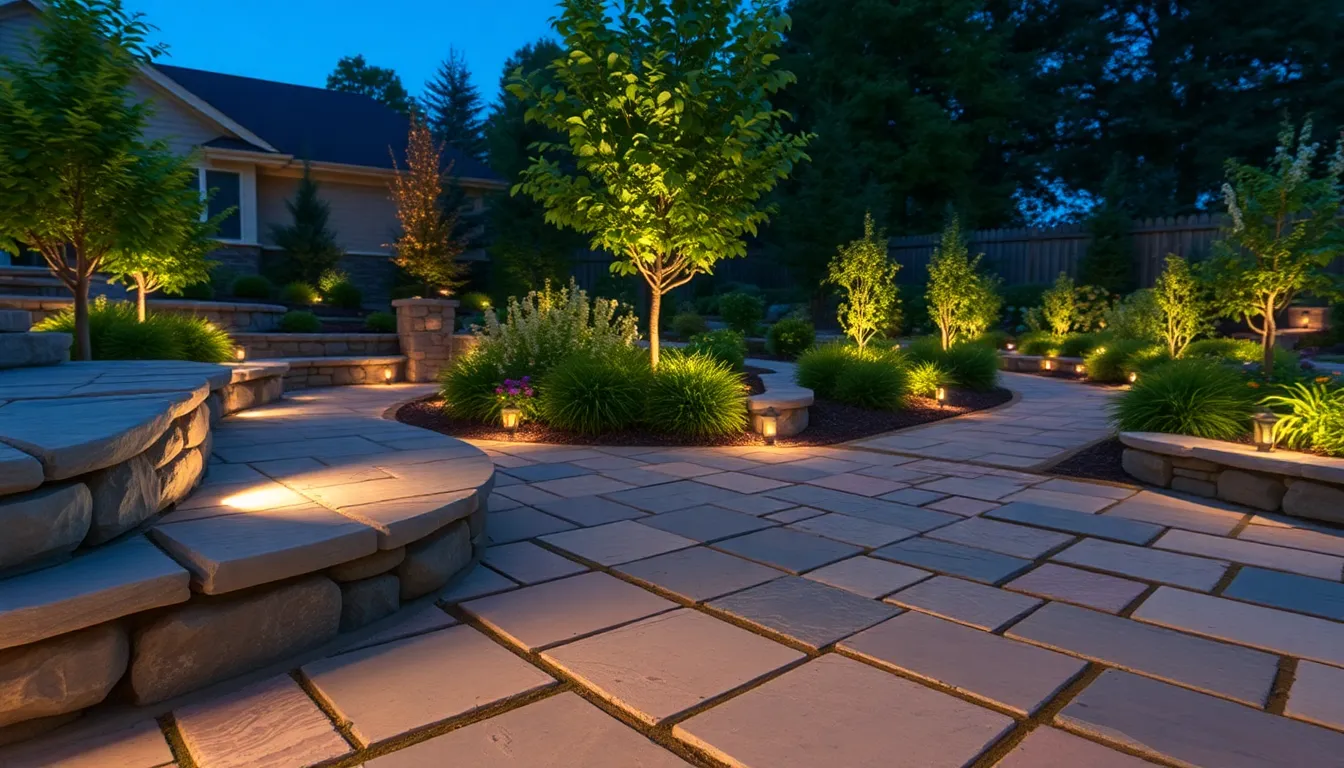
Proper lighting transforms our flagstone patios from daytime-only spaces into enchanting evening retreats. We’ll explore strategic lighting answers that enhance both safety and aesthetics for year-round outdoor enjoyment.
Uplighting Between Stones
Installing low-voltage LED uplights between flagstones creates a stunning ambiance that highlights natural stone textures. We position these discreet fixtures beneath stone edges to achieve a subtle glowing effect without overwhelming the space. This technique emphasizes the natural contours and irregular patterns of our flagstone installation while adding depth and visual interest after dark.
Low-voltage systems offer energy efficiency and easy installation, making them perfect for DIY flagstone lighting projects. We recommend spacing uplights every 6-8 feet along stone joints to create consistent illumination. Warm white LED bulbs enhance the earthy tones of flagstone while providing enough light for safe navigation around our patio areas.
Pathway Illumination Systems
Flagstone walkways require dedicated lighting systems to ensure guest safety and guide movement through our industry design. We install solar or low-voltage LED lights alongside walkway edges to create clear visual boundaries between paved areas and surrounding gardens. These pathway systems work particularly well with the slip-resistant texture of flagstone surfaces.
Motion sensors and automatic timers maximize energy efficiency while maintaining consistent illumination for evening use. We position lights at ground level or slightly recessed to avoid glare while providing adequate visibility for children and elderly visitors. Strategic placement every 4-5 feet along curved pathways creates a welcoming guiding system that enhances both safety and aesthetic appeal.
Accent Lighting Placement
Accent lighting around our flagstone patios focuses attention on key features like fire pits, seating areas, and water elements. We use spotlights and decorative lanterns to highlight these focal points while creating distinct zones for different activities. This approach combines aesthetic enhancement with practical functionality for safer navigation during outdoor entertainment.
Strategic accent placement illuminates level changes and steps within multi-tiered flagstone designs. We install fixtures to emphasize planters, fountains, and architectural elements that serve as natural room dividers. Small LED spotlights work excellently for highlighting textural contrasts between different flagstone patterns while maintaining the natural beauty of our outdoor living spaces.
Flagstone Joint Material and Filling Techniques
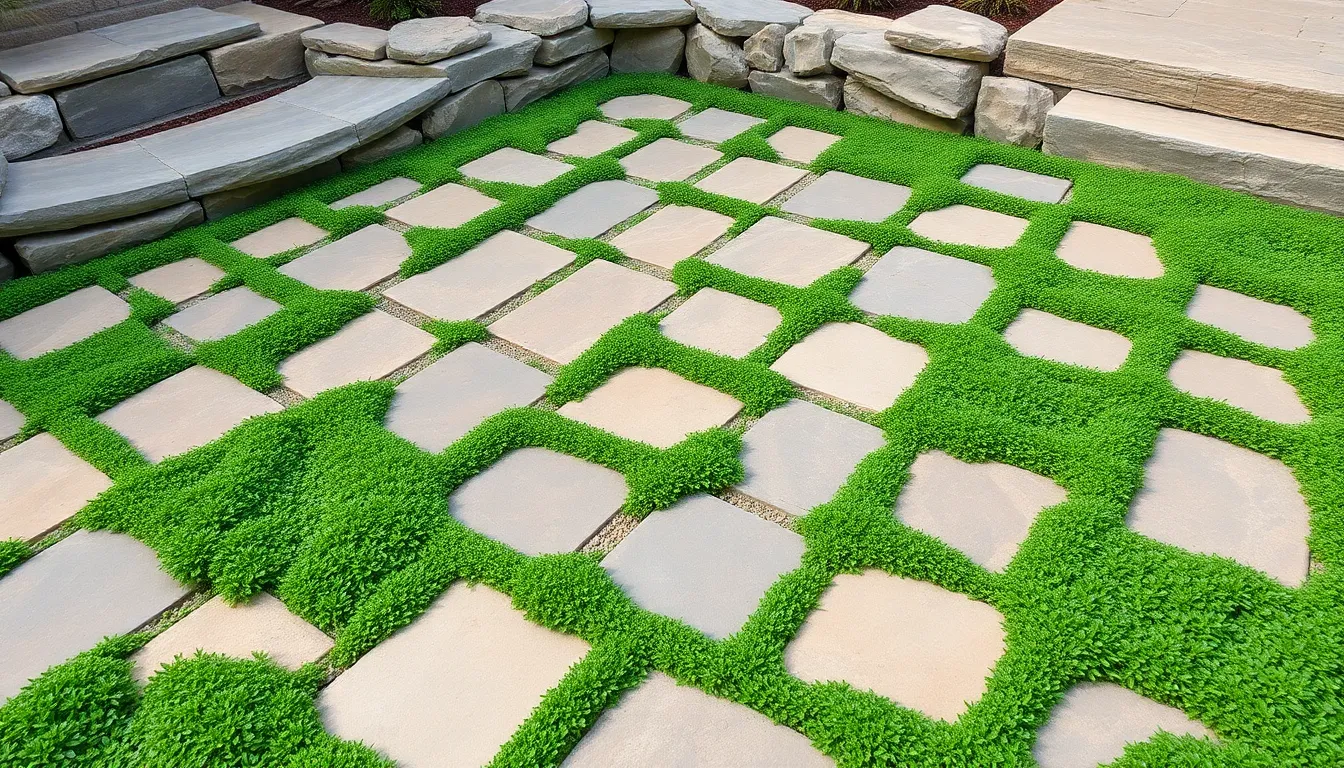
The materials we choose to fill the joints between flagstones dramatically impact both the appearance and functionality of our patio. These filling techniques determine everything from drainage effectiveness to maintenance requirements and overall aesthetic appeal.
Sand and Gravel Options
Sand provides one of the most practical and versatile joint filling answers for flagstone patios. Fine sand swept into joints creates a stable foundation while allowing proper water drainage and preventing weed growth. We recommend using polymeric sand for enhanced stability, as it hardens when activated with water to create a more durable joint fill.
Gravel offers excellent drainage properties and works particularly well for wider joint spaces. Small gravel or decomposed granite creates a permeable surface that blends naturally with outdoor environments. These materials provide texture contrast between stones while supporting effective water management. Decomposed granite compacts slightly over time, creating a firm yet permeable surface that complements the natural stone appearance.
Concrete and Mortar Applications
Mortar joints deliver maximum durability and stability for high traffic flagstone patios. This permanent solution creates firm bonds between stones while preventing weed growth and insect intrusion. Mortar works best when we want a more formal appearance and need long term structural integrity. The application requires professional techniques to ensure proper adhesion and weather resistance.
Concrete base installations provide the ultimate foundation for flagstone patios requiring exceptional stability. We typically use this method in areas with heavy foot traffic or where precise leveling is critical. The concrete slab foundation combined with mortar joints creates a virtually maintenance free surface that can withstand harsh weather conditions and constant use.
Living Ground Cover Alternatives
Creeping thyme transforms flagstone joints into living carpets that soften hard edges while adding natural fragrance. This low growing plant tolerates foot traffic exceptionally well and requires minimal maintenance once established. Thyme produces small flowers that attract beneficial insects, creating a more biodiverse patio environment.
Irish moss creates a lush, green carpet effect between flagstones that thrives in partial shade conditions. This plant forms dense mats that effectively prevent weed growth while maintaining a soft, natural appearance. We find Irish moss particularly effective in creating a cottage garden aesthetic that integrates seamlessly with surrounding industry plantings.
Corsican mint releases a pleasant fragrance when stepped on, making it an excellent choice for frequently used patio areas. This ground cover spreads quickly to fill joints while tolerating moderate foot traffic. The aromatic qualities enhance the sensory experience of our outdoor spaces, creating a more immersive natural environment that connects us with our patios.
Flagstone Maintenance and Longevity Tips
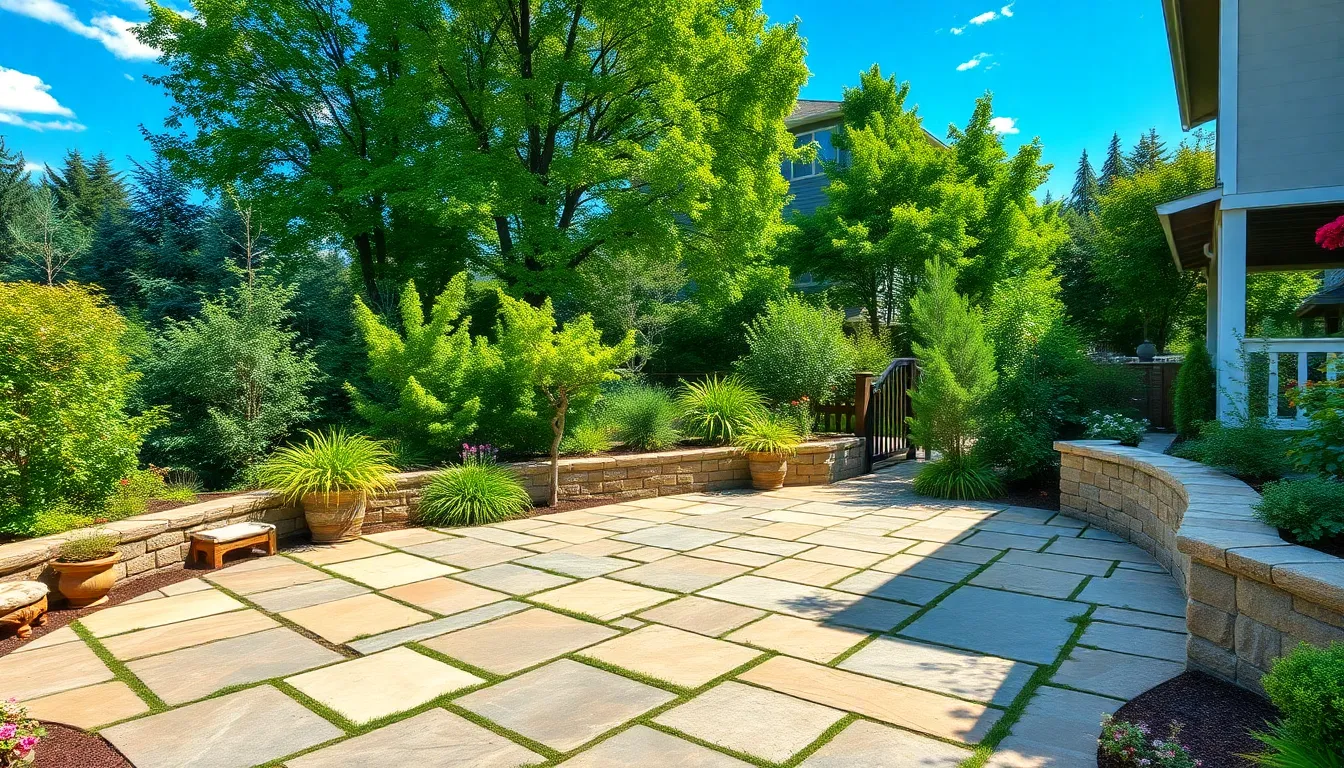
Proper maintenance extends your flagstone patio’s life from 20 to 30 years or more while preserving its natural beauty. Regular care prevents costly repairs and maintains the stone’s elegant appearance year round.
Sealing and Protection Methods
Apply high quality stone sealant designed specifically for flagstone to protect against moisture absorption and staining. Professional grade sealants create a protective barrier that prevents water damage and maintains the stone’s original color.
Clean sealed surfaces with mild, pH neutral cleaners that won’t degrade the protective coating. Avoid acidic cleaners like vinegar or harsh chemicals like bleach that can break down sealant effectiveness over time.
Inspect your sealant regularly for peeling or wear signs that indicate reapplication needs. Professional resealing restores protection and extends surface life when damage appears on the coating.
Schedule sealant reapplication every 2 to 3 years depending on weather exposure and foot traffic levels. High traffic areas may require more frequent sealing to maintain optimal protection.
Seasonal Care Requirements
Remove water, snow, and ice promptly during colder months to prevent freeze thaw damage that can crack stone surfaces. Standing moisture causes the most important long term damage to flagstone installations.
Sweep frequently during windy seasons to clear sand and debris that scratch or abrade stone surfaces. Weekly sweeping prevents buildup of materials that dull the stone’s natural luster.
Avoid harsh de icing chemicals that deteriorate both stone and sealant protection. Use sand or kitty litter for traction instead of salt based products that cause surface deterioration.
Pressure wash annually or every two years to remove algae, moss, and deep dirt buildup that regular cleaning can’t eliminate. This deep cleaning maintains the stone’s appearance and prevents permanent staining.
Repair and Replacement Strategies
Address small cracks and loose stones immediately by cleaning and refilling joints with mortar or polymeric sand. Early intervention prevents minor issues from becoming major structural problems.
Replace extensively cracked or broken flagstones by removing damaged pieces and resetting new stones with proper base preparation. This targeted approach maintains overall patio integrity without full replacement costs.
Seek professional assessment for major repairs when structural damage affects multiple stones or drainage systems. Expert evaluation ensures repairs maintain both appearance and long term stability.
Maintain proper drainage around repaired areas to prevent future water damage that causes the same problems. Good drainage extends repair longevity and protects surrounding stone installations.
Conclusion
Creating the perfect flagstone patio requires thoughtful planning and attention to detail. We’ve explored many design possibilities that can transform any outdoor space into a stunning retreat that reflects your personal style.
From rustic fieldstone charm to sleek geometric patterns your flagstone patio can become the centerpiece of outdoor entertainment. The integration of fire features lighting and water elements elevates these spaces beyond simple patios into complete outdoor living environments.
Remember that proper installation and maintenance are key to enjoying your flagstone investment for decades. With the right approach to drainage joint filling and seasonal care your patio will continue to provide beauty and functionality year after year.
Start planning your flagstone patio project today and discover how these timeless materials can enhance your outdoor lifestyle while adding lasting value to your property.
Frequently Asked Questions
What makes flagstone patios a good choice for outdoor spaces?
Flagstone patios offer natural beauty, exceptional durability, and versatility in design. They enhance property value while providing a stunning foundation for outdoor entertaining and relaxation. The natural stone withstands weather conditions well and can last 20-30 years with proper maintenance, making it a cost-effective long-term investment for homeowners.
What’s the difference between geometric and natural flagstone layouts?
Natural flagstone layouts use irregular, organic patterns with varying stone sizes to create rustic charm and authentic appeal. Geometric layouts feature precisely cut stones arranged in structured patterns like squares or rectangles, creating contemporary sophistication and modern aesthetics for outdoor spaces.
How do you integrate fire pits with flagstone patios?
Fire pits can be integrated using circular stone arrangements that encourage social gathering or rectangular fire tables for modern appeal. Create safety zones with stone borders around fire features, and arrange flagstone in accessible patterns. Consider adding LED lighting to borders for enhanced nighttime ambiance.
What safety considerations are important for flagstone pool decks?
Use flagstone with rough, non-slip finishes around pools to prevent slipping. Ensure proper joint spacing for optimal drainage and water runoff. Apply appropriate surface treatments and consider waterline stone transitions that provide seamless connections between pools and patios while maintaining safety standards.
How should flagstone patio joints be filled?
Joint filling options include sand, gravel, mortar, or concrete for different drainage and aesthetic needs. Living alternatives like creeping thyme, Irish moss, or Corsican mint add greenery and sensory appeal. Choose based on your climate, drainage requirements, and desired maintenance level.
What lighting options work best for flagstone patios?
Effective lighting includes uplighting between stones to highlight textures, pathway illumination for safety, and accent lighting for key features. Low-voltage LED systems work well for borders and safety zones. Consider warm-toned lighting to enhance the natural stone colors during evening use.
How do you maintain flagstone patios for longevity?
Apply high-quality sealants to protect against moisture and staining, and reapply as needed. Clean regularly and remove snow/ice promptly to prevent freeze-thaw damage. Inspect for loose stones or cracks, maintain proper drainage, and address repairs quickly to extend the patio’s 20-30 year lifespan.
What are the best pathway connection options for flagstone patios?
Three main approaches work well: meandering garden walkways with curved patterns, straight access routes for high-traffic areas, and stepping stone transitions that blend hardscape with natural elements. Each option should complement your overall landscape design while providing functional connections.

